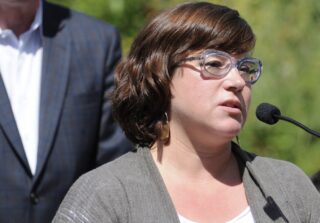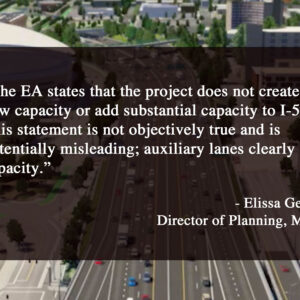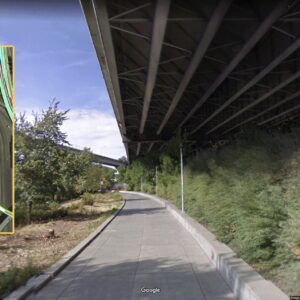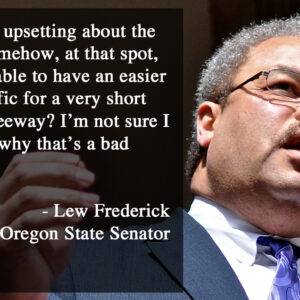
(Photo: Jonathan Maus/BikePortland)
In yet another piece of very good news for people who are concerned about the Oregon Department of Transportation’s plans to expand Interstate 5 through the Rose Quarter, Portland City Commissioner Chloe Eudaly released a pointed statement via Facebook about the project on Tuesday evening.
Eudaly said she’s joining the Portland Public Schools Board, Albina Vision, and other groups in calling for a more thorough analysis of the project’s impacts to the community. “I believe it’s more than called for,” she wrote, referring to her belief that ODOT should complete a full Environmental Impact Statement (EIS) instead of just an Environmental Assessment (EA, learn more about the differences between the two here).
“The added auxiliary lanes on I-5 will not deliver meaningful safety, environmental, or equity benefits to Portland.”
— Chloe Eudaly, Portland City Commissioner
Going further, Eudaly expressed serious doubts about the project. She dismissed its planned freeway expansion and surface street improvements as merely “nice” and said, “As it stands the added auxiliary lanes on I-5 will not deliver meaningful safety, environmental, or equity benefits to Portland.”
Despite her misgivings, Eudaly says since funds for the project were passed by the legislature (via HB 2017, which included $30 million to pay for project bonds starting in 2022), there’s nothing she and her City Council colleagues can do about it. “These funds, which come from the State Highway Fund, are restricted and not under my control, neither is the highway, or any ODOT owned properties in our city,” she wrote. Eudaly also revealed that she’s been told if the I-5 Rose Quarter project dies, the funds would simply be reallocated to another freeway expansion project in the region. (Note: Eudaly refers to “all $500 million for the highway and surface streets,” but that’s not what the legislature has approved for the project.)
Advertisement
Eudaly also echoed the opinion expressed by Metro Council President Lynn Peterson on Monday, that ODOT needs to do much more to embrace the Albina Vision plan. She even used the term “remediation” when calling for ODOT to do more to mitigate the harms of past Rose Quarter developments on black people who lived in the now-razed Albina neighborhood. Remediation is the same word used by Albina Vision spokesperson Rukaiyah Adams in her own stinging assessment of ODOT’s conduct around the project thus far.
“I urge all who support this approach to contact the OTC and let them know that you support Portland’s Central City Plan and expect congestion pricing to be part of any work on the I-5 corridor.”
And despite ODOT’s attempts to decouple congestion pricing from this project, Commissioner Eudaly said she thinks making people pay to drive on this section of the freeway is “the best solution for reducing traffic.” She feels so strongly about congestion pricing she plans to send a letter to the Oregon Transportation Commission (OTC, the governor-appointed body that oversees ODOT), “reminding them” that the Portland’s Central City Plan was amended last year specifically to ensure that congestion pricing is in place prior to the completion of the I-5 Rose Quarter project.
“I urge all who support this approach to contact the OTC,” Eudaly wrote, “and let them know that you support Portland’s Central City Plan and expect congestion pricing to be part of any work on the I-5 corridor.”
As per HB 2017, all revenue collected from congestion pricing would go into a “Congestion Relief Fund.” ODOT spokesperson Don Hamilton told me via email in February 2018 that, “Specific decisions about how to allocate those funds will be determined later.”
Eudaly’s statement puts the City of Portland in a strange position: For many months now, ODOT staff has touted the close partnership and support they have from PBOT on this project. Now PBOT staff are in the awkward position of having to work on a project their own Commissioner isn’t too thrilled about.
In related news, the Congress for New Urbanism put I-5 on its list of Freeways Without a Future report released today.
CORRECTION, 4/4: An earlier version of this story said revenue from Congestion Relief Fund would be managed via the State Highway Fund. That was incorrect. New tolling revenue would not be part of the highway fund. I regret the error.
— Jonathan Maus: (503) 706-8804, @jonathan_maus on Twitter and jonathan@bikeportland.org
Never miss a story. Sign-up for the daily BP Headlines email.
BikePortland needs your support.





Thanks for reading.
BikePortland has served this community with independent community journalism since 2005. We rely on subscriptions from readers like you to survive. Your financial support is vital in keeping this valuable resource alive and well.
Please subscribe today to strengthen and expand our work.
The city has been pushing for congestion pricing to work in this way since at least June of 2018, if not earlier. Starting on page 45 of this document you can find a letter from City Council to ODOT pushing for a better congestion pricing program, one that is designed to manage demand. https://www.oregon.gov/ODOT/Value%20Pricing%20PAC/20180705_VP-PAC-Rec-to-OTC.pdf
A coalition of community organizations and local governments asked for the same thing starting on page 56. Hopefully we can salvage that proposal to create meaningful benefits, expand transit, and reduce demand on our highways rather than induce demand on our highways.
Congestion pricing, yes! But, not like Manhattan’s new congestion pricing which has so many loopholes and exceptions as to render it useless.
Instead of keeping it simple, it will be over-complicated by demands from various interest groups and their complex processes to ensure “progressive” based fee structures which will be nearly impossible to implement.
When I saw the headline I had the over/under for Political Snark from Middle of the Right Guy at within 5 comments. Those who bet the under, congrats!
He’s 100% right, though. Do you really think Portland would implement a simple, effective congestion pricing model? There would be convoluted exceptions for low-income drivers, non-profit vehicles, cannabis delivery trucks, etc.
One of the benefits of telecommuting is that I get to browse my favorite websites 🙂
Sounds like your employer is getting a heck of a deal..
I work efficiently and apply my specific knowledge and experience where best needed. That allows me to have a work-life balance. Having been with the same company for over 10 years, I believe they feel the same way.
“These funds, which come from the State Highway Fund, are restricted and not under my control, neither is the highway, or any ODOT owned properties in our city”
To be clear, the City of Portland is NOT kicking in any money for this project? I understand that the actual highway widening is an ODOT deal, but what about all the city streets being widened/modified as a result of this project?
Surely there is a lot of coordination needed between ODOT and the City of Portland, and it now looks like 2 of 5 are against this project (Hardesty was already opposed.)
Exactly… One reason ODOT was able to get PBOT to carry so much water for this project was the promise of $250 million in surface street infrastructure. PBOT jumped at the chance because they think it’s an opportunity too good to pass up. But when you lay down with dogs you tend to wake up with fleas.
Personally I’m very skeptical of the idea that ODOT and PBOT — who but heads constantly on projects all over the city and who have completely different agency values and cultures — can successfully partner on a project of this scope.
Also important to note that this $250 million is a made up number, an ODOT talking point that has no source and unfortunately gets repeated by officials. The nature of this $500 million project is a freeway widening with some surface improvements included.
If we had $250 million to spend on surface improvements in the RQ we would have quite a different project on our hands — cycle tracks on every street, dedicated transit lanes, fix up the RQ transit center, wider sidewalks, slow avg vehicle speeds, designated tlc areas, etc.
The I-5 bridges were built with tolls. Start tolling them again to reduce unnecessary trips like “tax free shopping”, maybe it will raise a little money for future highway improvements if the tolling doesn’t reduce the traffic significantly. Tolling would encourage carpooling and mass transit options too. Do the least expensive options first, not the most expensive option first. With the bridge and rose quarter improvements the future predictions are you’ll save 2 minutes. Good luck Portland from Slovenia.
I’m wholeheartedly in favor of making motorized transportation’s cost to be more reflective of the burdens it places on society (i.e. global warming, poorer public health, injuries, etc.).
In my opinion, the best way of making motorized transportation less-used and accountable for the harm is to increase the cost. The best way to increase the cost is to increase the cost of every mile driven. A gas tax approximating European standards would be a good start.
A toll on I-5 or a congestion tax in a corridor or in a specific area may reduce some motorized travel, but only in the affected area. There will be predictable consequences of a toll on I-5 or a congestion tax: shifting to untaxed facilities (MLK or Barbur instead of I-5) as well as businesses and employers moving out of the “congestion zone.”
If you need an example of the consequences of tax policy, you need look no further than the 55,000 Washington residents who commute daily to Oregon for employment. Lower housing costs and “better” schools are sometimes cited as reasons for the selection of Vancouver as a residence, but those are also attributable to Washington’s absence of an income tax.
A congestion tax or tolls are not going to accomplish as much as proponents hope for and will have some unintended, but highly predictable, consequences.
WA people who commute to OR for work pay Oregon income tax
Yes, you work in a state, and you pay income tax on the income you make there. Oregon has the business environment that created the jobs, so it has the right to tax them. Very little of that income tax money goes to road funding. If we are going to have to spend billions to build new Interstate lanes for Washington commuters, they need to pay up.
Chris: I simply stated a fact and was responding to J_R ‘s statement re tax policy, the 55,000 washington commuters and WA’s lack of an income tax but thanks.
Keep in mind that any income not directly related to an Oregon job is not taxed for Washington residents. If they have rental properties in Washington, investment income, a spouse that works in Washington, etc. I don’t think he was trying to imply that they don’t pay any income tax on Oregon employment.
If you don’t like that example, here’s another. Check the ratio of Washington and Oregon licence plates at the Home Depot stores at Janzen Beach, Airport Way, Padden Parkway, and SE 1st. People make decisions about where they spend money based on fees and taxes.
Only on their Oregon wages, not on any other income such as interest, dividends, retirement, social security, etc.
I believe they still need to include their federal tax form when filing in Oregon. So they may have only made 30,000 in oregon but if filing jointly with their spouse they pay taxes on the highest bracket for that 30,000.
As the City proposes to cut nearly $900,000 for operations from PP&R’s budget, this is a good time to start asking who will be operating the proposed new “openspaces” that are being planned to be built on concrete lids over I-5 as part of the Rose Quarter expansion. These lids will be surrounded by busy, multi-lane roads and to save money on ventilation, they will not be connected. That means they will be hard to get to and will be subject to the highway noise and air pollution as well as the traffic noise and air pollution from the surrounding arterials and highway ramps. These openspaces will not be connected to any commercial, civic or residential buildings so they will be very hard to activate or program meaning they will likely be desolate. They are being shown as “parks” and as green, treed spaces, but who will operate them and who will pay for maintenance? In our climate with summers getting hotter, drier and longer, any soil placed over concrete will need permanent irrigation to support plant life. When soil is connected from the earth, it no longer get the benefit of small amounts of moisture reserves that migrate up through the soil through the dry period. Soils over structures dry out quickly and completely and plants cannot root deeply to compensate and they die. PP&R has to pay municipal water rates for irrigation, same as anyone in Portland. With their already stretched budget, is it prudent to ask them to take on a water bill in perpetuity for a poorly planned, underused and unpleasant openspace? On top of water fees, their will be fees for Ranger patrols, trash pickup, lighting, water and sewage for drinking fountains and restrooms (if included). and general maintenance like graffiti removal, leaf removal, etc. If the Rose Quarter Highway widening project continues, I urge people to demand answers to these qquestions so these new opnespaces do sap funds from the already overburdened PP&R
And the reason for congestion tolling is what? Both Portland and Multnomah County will derive huge amounts of tax revenue from the big buildings going in the urban renewal zones. Congestion tolling is an unprecedented governmental burden, for Oregon. That’s not the way we do things.
To eliminate wasteful trips and reduce congestion during the busiest times. It has a lot of precedent around the world. I don’t know where you are getting the facts behind your statements.
Maybe you can start here:
https://en.wikipedia.org/wiki/Congestion_pricing
With all due respect, most of my voluntary time on transportation stuff is figuring out ways that things can be done for less cost. I’m sympathetic to cyclists because that gets more traffic off the roads. However, what I have been seeing—and unusual for Portland—is an incredible ballooning of costs on projects. This can also includes costs for projects for the alternative modes.
One thing that I saw some success on—and you won’t read in the news—- was urging ODOT to revise their projections on seismic upgrade. They were seriously tossing around $5 billion est. a few years ago. Now they are targeting areas that are truly riskier and the estimates are down 80-90 percent. Of course the CRC, also, was wasteful spending, nearly any way one could look at it. I was for the original light rail in Portland. But now it is no longer cost-competitive among potential modes.
However—assuming that the SW corridor light rail goes ahead—I asked METRO if they would consider having the ped-bike path on a separated row adjacent to Barbur–as opposed to removing lanes. My point is—-this is a construction problem, not just a planning or political or problem. Therefore there often can be cost effective construction solutions that should make any project less of a burden. As far as things like bike bridges, for example, I would suggest something like engineered wood or prefab steel. No—they always go with the standard, and expensive, poured in place concrete. So if these things could be handled cost effectively, when they can be, strategies like adding expensive tolls should not be needed. And as far as paying for alternative modes, our huge additional tax revenue should handle that, eh?
Pork Barrel ODOT rolling in the 2016 Transport Package with no CEO or auditors watching the purse strings. Pray the new Secretary of State gets a new audit going soon.
Furthermore
I now live next to PCC Sylvania and honestly can’t figure out why they are proposing a tunnel for the Southwest Corridor when a BRT would be a fraction as much and three times faster to implement. PCC Sylvania is on a mountain with an underutilized community college campus that primarily functions as an auto repair shop, bus parking, and seas of empty parking lots. And lots of empty bathrooms and pool facilities. It would be a perfect spot for another Right to Dream camp. There’s not enough transport demand for a zoo like tunnel Max station. Chloe lets get a Right to Dream camp out here at PCC Sylvania. We care!!! And love you very much <3
Are they really talking about a special tunnel serving PCC? I haven’t been following that issue–but seriously PCC is only a few blocks up from the current stop on Barbur. They do believe in exercise don’t they? I guess the light rail path is further away. I hope it gets stopped.
Double decker buses could handle the SW corridor just as well. And could be implemented with out a lot of fanfare.
Think outside the box a bit. There are several ways to control infrastructure costs. You can attack the projects themselves, and value engineer there. You can also attack the demand. Part of the reason highway projects are so expensive is because we are building capacity based on peak demand. If you can level out the demand curves, you will find that these expensive projects aren’t needed at all. I’ve never had problems driving I-5 at 5am, or 11pm. It’s a demand problem.
But this is no longer the typical Portland we’re living in. It’s growing exponentially. Whatever we do is going to end up being outmoded in short order. And I don’t think the ‘reduced demand’ model is easy to implement. In the case of the Rose Quarter and I-5 widening what we have is a sort of “for all time” plan—-not be revisited…. maybe never.
I do think we need to look at a other ways to accomodate travel. I had been asking Cong. Jaime Herrera Beutler’s staff if there was any way to get a federal study of an AMTRAK service. The Sounder is gradually going up in ridership. I think it would work in this area—but don’t know what the subsidization rate would be.
Portland urbanista’s like to talk about things like removing I-5 and tunnels, etc. I don’t think this is appropriate now, while the costs are high. However, construction technology is making a lot of advances—so doing things like covering I-5 may be much more cost efficient in the future. And boring tunnels—after we see what Elon Musk can do with the Boring Company. In other words, hold that thought.
This project really needs to be coordinated with the future I-5 Columbia River Bridge replacement project that is eventually coming. The origional CRC project that was torpedoed by the Clark County GOP due to fear and loathing of light rail was really more of a giant freeway expansion combined with a bridge. This project looks to be a freeway expansion disguised as access lane improvements. Both projects have had some type of tolls proposed.
Would really make more sense to look at I-5 comprehensively from downtown to Vancouver and look at what type of lane improvements, bridge improvements, light rail, other transit, and congestion pricing makes the most sense.
Of course that would be too much to ask.
Start with the tolls, understand the impacts they have demand, use the revenue to improve the corridor in a way that makes sense for all modes of travel.
Finally, something I can agree with Chloe on.
Thank you, Commissioner Eudaly!
Ahhhh…the ship has already sailed.
We need to suck it up and build the western arterial highway, too.
A shortcut will benefit all modes.
Thank you! (And shameless plug)
Article posted this very morning by DJT’s fave newspaper:
https://www.nytimes.com/2019/04/04/upshot/the-streets-were-never-free-congestion-pricing-finally-makes-that-plain.html?action=click&module=Editors%20Picks&pgtype=Homepage
Can anybody here fill me in on the status of the PBOT and ODOT director selection efforts? Those seem like the choices by electeds that will really determine
a) the scope of decongestion pricing and how the money would be spent
b) whether ODOT follows through on its gun-to-the-planet’s-head threat of reallocating the money to a bigger freeway in the burbs, which seems to be Rian Windsheimer’s main point of leverage against freeway critics
c) lots of other stuff
To the extent that transportation reformers have the attention of electeds thanks to doing so well in this battle against Windsheimer and his allies at ODOT, seems like a possible opportunity to shape these very important staffing decisions, too.
Great point Michael. The City of Portland and the Oregon Dept. Of Transportation are resting on a pile of money with projects in the pipeline, and seem to be fumbling around, getting little done, with much at stake. Considering the “Transportation Nightmare” that Portland is now, some strong leadership is sorely needed.
Another Fixing Our Streets proposal will be on the ballot soon and I find myself skeptical about voting for it. While the COP has done a pretty good job with the FOS projects, little else is being done to build already funded projects promised years ago.
Ask and ye shall receive https://bikeportland.org/2019/04/04/guest-opinion-from-the-street-trust-pbot-director-job-description-isnt-bold-enough-297922
And here’s an update on the ODOT Director search, just released by ODOT:
It’s really quite annoying the way public comment works for state legislature. I understand this is a part time job for legislators so making hearings at 7pm is not that feasible, but to get to the OR Legislature in Salem from Portland by 3:45pm means planning to leave around 2:30 to account for traffic and spend a lot of money on gas… just to give public testimony. I know we can write in too but in person testimony always seem to sway people more than written.
Sorry OTC is separate from ORLeg. My mistake. But the time requirement and lack of affordable non-driving options limits how frequently I would realistically consider giving public testimony.
The Powers That Be could designate ALL of the lanes of I-5 from Salem OR to Ridgefield WA as “carpool lanes” from 6AM to 10AM and again from 3PM to 7PM.
Drivers could meet in designated parking lots on either end (and along the way) to get paired up. Problem solved overnight. No freeway expansion required. Those never work, anyway. The cars just fill existing voids, requiring more paving.
You know what’s a real travesty here? To this day it’s impossible to stay in a single lane from the Oregon line to the 405 merge without constantly changing lanes. It’s a mess. You know what else is a travesty? To this day, there is no HOV lane on I-84 east or west to be used during crush hour. So yeah, come one advocacy groups…let’s get to the basics before we funnel cold hard cash to ODOT in the form of a new tax.
As per HB 2017, all revenue collected from congestion pricing would go into a “Congestion Relief Fund.” ODOT spokesperson Don Hamilton told me via email in February 2018 that, “Specific decisions about how to allocate those funds will be determined later.”
They all have dollar signs in their eyes.
This is Portland, so it will probably go to housing for non-white people. Jobs programs for non-white people. Maybe some female only busses?
Unless that money is directly tied to increasing transit and/or buying passes for the poor, minority, disabled and people under 18, it will just become a slush fund to enable more driving.